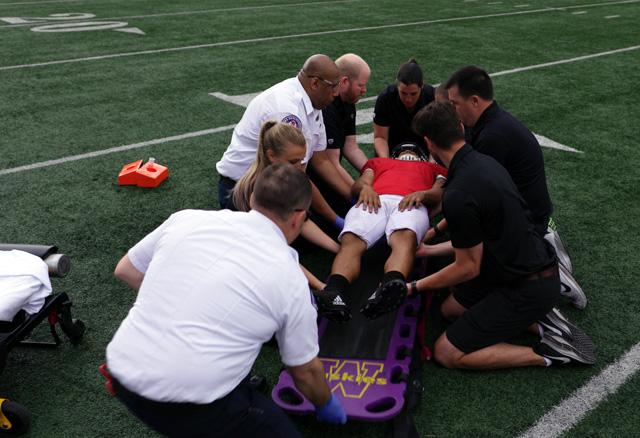
Guidelines issued for spine injuries in football
National Athletic Trainers' Association releases consensus recommendations for emergency prehospital care.Media Contact:
- Honey Hamilton, NATA, honeyh@nata.org, 972, 532.8812
- Robin Waxenberg. Robing Waxenberg & Associates, robin@robwax.com, 917.301.1350
- Susan Gregg, sghanson@uw.edu, 206.390.3226

Sports at every level is being re-evaluated for safety of play going into this summer and fall. In addition to COVID-19 considerations, the awareness of the critical nature of athlete safety and emergency preparedness is at an all-time high. Sports participation is among the leading causes of catastrophic cervical spine injury in the United States. This injury can have devastating and lasting effects on athletes and their families. Evidence-based care is essential to maximize the potential for positive outcomes.
Two articles stemming from meetings of the Spine Injury in Sport Group were published June 24 in the Journal of Athletic Training, the National Athletic Trainers’ Association (NATA) scientific publication. The first, Best Practices and Current Care Concepts in Prehospital Care of the Spine-Injured Athlete in American Tackle Football Players, outlines best practices and practical applications. Consensus Recommendations on the Prehospital Care of the Injured Athlete with a Suspected Catastrophic Cervical Spine Injury outlines the process, which identified eight key questions to be answered by systematic review and was used to reach a consensus.
The review screened 1,544 studies, 49 of which were included in the final full-text review. Additionally, a high-quality training film was created to complement the recommendations and to visually communicate the guidelines across medical professions and other key stakeholders.
To mirror the diverse health care professions that may be involved in a spine injury, the SISG consisted of 25 health care professionals in athletic training, emergency medicine, sports medicine, neurologic surgery, orthopaedic surgery, neurology, physiatry and research. The National Athletic Trainers’ Association, The Sports Institute at UW Medicine, National Collegiate Athlete Association, and the Harborview Injury Prevention and Research Center (HIPRC) were instrumental in the creation of educational materials.
Key Recommendations
- Athletic programs should have an emergency action plan developed in conjunction with local emergency medical services agencies specific to pre-hospital spine-injury care. Best practices are for an athlete with a suspected spinal injury to be transported to a designated Level 1 or 2 trauma center as quickly and safely as possible.
- Sports medicine teams should conduct a pre-event medical time out before each athletic event (practices and competitions). Participating in these “time outs” should include medical personnel from both teams, EMS personnel and game officials.
- When feasible, those with the highest level of training and experience in removal techniques should participate in equipment removal. Athletic trainers are recognized as the medical professional with the most training and experience in athletic equipment removal.
- Removal of the helmet and shoulder pads can occur in the emergency room or on the field. There are potential advantages to on-field removal prior to transport to the hospital, such as improved airway management, access to the chest for CPR, and expedited care of the athlete. The decision to remove equipment before transport should be based on a variety of factors, such as the medical status of the injured athlete, type of equipment worn, number of onsite rescuers and training and experience of on-the-field and emergency room rescuers in equipment removal.
- If a spine board is used in the care of an athlete with a suspected cervical spine injury, non-athlete data recommends that time on the board be minimized, however, the board is left in place for transport to the hospital.
- If feasible, spine-injured athletes should be transported to a medical facility that can deliver immediate and definitive care in the event the athlete has a significant cervical spine injury. This includes: an emergency department with certified emergency medicine physicians; personnel trained in equipment removal; advanced imaging services; spine surgeon consultation in house or readily available; 24/7 operating access; and critical care monitoring and rehabilitation services.
“When an athlete is suspected to have a spine injury, every moment and every movement counts,” said NATA President Tory Lindley. “It is imperative that no matter the level of play, from peewee to professional, there is a health care professional, such as an athletic trainer, that creates venue-specific action plans, leads medical time outs and establishes relationships with allied medical professionals to ensure the best possible outcome for the athlete.”
“I have enacted emergency protocols for the pre-hospital care of a spine-injured athlete several times during my career and have seen first-hand the monumental and lasting effects that it can have on both the athlete and family,” said Ron Courson, co-chair of SISG and senior associate athletic director at the University of Georgia. “My experience has driven home the paramount importance of having rehearsed and evidence-based protocols ready to implement.”
“The Spine in Sport Group consisted of over 200 years of professional medical experience. With such an impressive group of subject matter experts, we wanted to ensure that each voice counted. We implemented the Delphi process to ensure that science spoke the loudest rather than the person with the most impressive title or loudest voice,” said Jim Ellis, co-chair of SISG and clinical associate professor of emergency medicine at the University of South Carolina School of Medicine-Greenville.
“The care of the spine-injured athlete is dependent upon the collaboration of medical professionals from athletic trainers, to EMTs/paramedics, team and emergency physicians and beyond. It was deemed critical that in addition to the articles, we created a high-quality visual component to allow for efficient and effective training across disciplines,” said Stanley Herring, co-chair of SISG and senior medical advisor of The Sports Institute at UW Medicine and a clinical professor of rehabilitation medicine, orthopedics and sports medicine, and neurological surgery.
For details about UW Medicine, please visit https://uwmedicine.org/about.